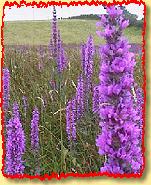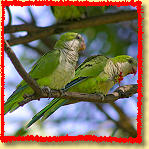
Invasive Species

Almost half of the plant and animal species in the United states that are protected by the Endangered Species Act are at risk primarily because of competition of predation by invasive species
|
 The introduction of non-native species to natural ecosystems is recognized as a significant threat to the native ecological processes. Non-natives may politely coexist with native inhabitants or they may aggressively displace the current species. The best way to keep a wild area naturally wild is to prevent the propagation of non-native plants and animals.
The introduction of non-native species to natural ecosystems is recognized as a significant threat to the native ecological processes. Non-natives may politely coexist with native inhabitants or they may aggressively displace the current species. The best way to keep a wild area naturally wild is to prevent the propagation of non-native plants and animals.
This might sound like a simple thing to do, but in our age where foods are shipped around the world, people fly from coast to coast, and we throw out what we no longer want, the introduction of non-native species is hard to control. A parakeet escapes from its cage in Florida and joins those already flourishing in the warm climate. A fruit core is tossed out to germinate and begin a grove of new trees. A foreign clam attaches to a ship and lets go in a port across the ocean, starting a new colony. Burrs are combed out of a pet's fur and tossed on the driveway where they are washed down the sewer drain and into a local marsh.
It is very easy to spread living organisms into new environments. When we explore the wild places of our country, we need to be aware of how we may accidentally disrupt the ecological balance by transporting species in our travels.
 What Can I Do?
What Can I Do?
Lots! Each of us can make a difference in our own little part of the world, even if we don't go out into the wilds:
- Learn what species are non-native. There is a lot of information at the National Invasive Species Information Center where you can find plant, aquatic, and animal invasive species by state or search. Being able to recognize the more troublesome species in your area helps you prepare to fight the problem.
- Tell Your Friends. Spreading the word to stop the spread increases the number of people to help in the battle. Organizing a short hike of any organization to which you belong can be a great way to show people just how bad the situation is.
- Clean Your House. Take inventory of your yard and surroundings. Make sure you are not planting any invasive species that may spread to local natural areas.
- Volunteer. Sign up with local groups to help eradicate invasive problem spots. Go out and actually pull plants, help inspect boats, or whatever work is needed.
- Do not release unwanted pets. Give your pet to the local animal shelter where it can be adopted or killed.
 Specific jobs for those of us that explore nature can help prevent the spread of non-native species:
Specific jobs for those of us that explore nature can help prevent the spread of non-native species:
- Inspect and wash your boat when you remove it from water. Aquatic hitchhikers spread from lake to lake on props, trailers, and other gear.
- Eat carefully. Dropped seeds from snacks and fruits can grow and produce more seeds in just a year.
- Clean your clothes, tent, and gear before packing up camp. Remove stickers, burrs, seeds, mud, and other organic matter from your boots, socks, pants, and other gear. Do this before you move to a new spot - if you sweep out your tent at your new campsite, it's too late. When you clean your gear at home, don't throw the material into your yard - use the garbage. Also, inspect your dog on the trail as well as stock animals.
- Use certified weed-free feed for pack animals, beginning at least three days before entering the wild lands. Whether the feed spills or is deposited as animal waste, the seeds may grow into plants.
- Do not release live bait when fishing.
As we continue to enjoy our outdoors in ever increasing numbers, our diligence in preventing and correcting non-native species invasions becomes more and more important. If we do our part to prevent the spread before it occurs, we save on the expense and controversy of eradication projects.
Take the extra few minutes on a hike, fishing trip, or backpack trek to check for hitch-hikers and leave the inhabitants in their rightful habitats.

